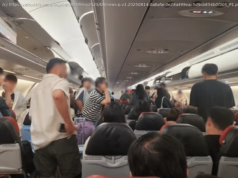«Eventually they’ ll go too far, and the situation will unravel.»
For decades, presidential administrations have tried — and failed — to curb North Korea’s nuclear weapons program. The Trump administration’s approach so far has been both aggressive and confusing. Two months ago, for example, Secretary of State Rex Tillerson that read: “The United States has spoken enough about North Korea. We have no further comment.” Does that mean negotiations are over? It’s not clear. that America’s policy remains a denuclearized North Korea, not regime change, but it’s apparent that relations between North Korea and the United States are increasingly strained. And tensions are likely to intensity after North Korea decided on Sunday to, this time firing a short-range ballistic missile that fell into the sea inside Japan’s exclusive economic zone. This was North Korea’s third missile test in as many weeks, and another sign of regional volatility. To understand how close we are to full-scale conflict in North Korea, I reached out to Jeffrey Lewis, director of the East Asia Nonproliferation Program at the Middlebury Institute of International Studies. Lewis focuses on nuclear nonproliferation, international security, and disarmament, and he is the author of I asked Lewis to lay out some of the worst-case scenarios in North Korea. Here’s what he told me.






